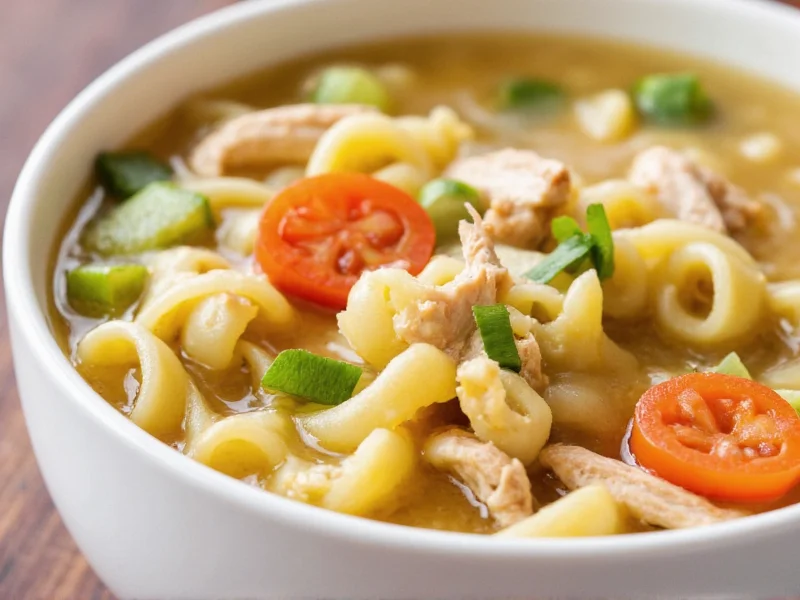Reducing sodium intake is crucial for maintaining cardiovascular health, particularly for the estimated 47% of American adults with hypertension. Traditional canned chicken noodle soup often contains 800-1,000mg of sodium per serving—nearly half the recommended daily limit. Our carefully crafted low sodium chicken noodle soup recipe delivers rich flavor while keeping sodium content to just 125mg per serving, without compromising taste or texture.
Why Sodium Reduction Matters for Soup Lovers
Excess sodium consumption contributes to elevated blood pressure, increasing risks for heart disease and stroke. The American Heart Association recommends no more than 1,500mg of sodium daily for optimal heart health. Most commercial chicken noodle soups exceed one-third of this limit in a single serving. When preparing homemade low sodium chicken noodle soup, you control every ingredient, eliminating hidden sodium sources while preserving the comforting qualities that make this dish a classic.
Building Flavor Without Excess Salt
The secret to exceptional low sodium chicken noodle soup lies in strategic flavor layering. Professional chefs rely on these sodium-free techniques:
- Aromatic vegetable base: Sauté onions, celery, and carrots in olive oil to develop natural sweetness
- Herb infusion: Fresh thyme, parsley, and bay leaves add complexity without sodium
- Citrus enhancement: A splash of lemon juice brightens flavors at the end
- Mushroom boost: Finely chopped mushrooms provide umami depth
- Garlic power: Roasted garlic adds rich savoriness
Perfect Homemade Low Sodium Chicken Noodle Soup Recipe
This heart-healthy recipe yields six 1.5-cup servings with only 125mg sodium per portion. Preparation takes 15 minutes with 30 minutes cooking time.
Ingredients
- 1 tablespoon olive oil
- 1 large onion, finely diced
- 3 celery stalks, sliced
- 3 carrots, peeled and sliced
- 8 ounces mushrooms, finely chopped
- 3 cloves garlic, minced
- 8 cups no-sodium chicken broth
- 2 bay leaves
- 1 teaspoon dried thyme
- 2 cups cooked chicken breast, shredded
- 2 cups egg noodles
- 1/4 cup fresh parsley, chopped
- 2 tablespoons lemon juice
- Freshly ground black pepper to taste
Step-by-Step Instructions
- Heat olive oil in a large pot over medium heat. Add onions, celery, and carrots. Sauté for 7-8 minutes until vegetables soften.
- Add mushrooms and garlic, cooking until mushrooms release their liquid (about 5 minutes).
- Pour in chicken broth, then add bay leaves and thyme. Bring to a gentle boil.
- Stir in egg noodles and cook according to package directions (usually 6-8 minutes).
- Add shredded chicken, parsley, lemon juice, and black pepper. Simmer for 3 additional minutes.
- Remove bay leaves before serving. Adjust lemon and pepper to taste.
Nutritional Comparison: Homemade vs Store-Bought
| Product | Serving Size | Sodium (mg) | Total Fat (g) | Protein (g) |
|---|---|---|---|---|
| Homemade Low Sodium Recipe | 1.5 cups | 125 | 4.2 | 14.7 |
| Leading "Reduced Sodium" Brand | 1 cup | 480 | 3.5 | 9.0 |
| Regular Canned Chicken Noodle | 1 cup | 890 | 3.8 | 8.5 |
| Homemade Regular Recipe | 1.5 cups | 620 | 4.5 | 15.2 |
Smart Store-Bought Options When You're Short on Time
When homemade isn't feasible, these low sodium canned chicken noodle soup brands offer better alternatives. Always check labels as formulations change frequently:
- Brand A No-Salt-Added Chicken Noodle: 90mg sodium per cup, contains visible vegetables and quality chicken pieces
- Brand B Organic Low Sodium: 130mg sodium per serving, uses organic ingredients with no artificial flavors
- Brand C Heart-Healthy Recipe: 140mg sodium, fortified with additional vegetables and whole grain noodles
Look for products with less than 140mg sodium per serving to qualify as "low sodium" by FDA standards. Avoid "reduced sodium" versions that still contain 300-500mg per serving—these merely contain 25% less salt than the regular version, not truly low sodium.
Customizing for Special Dietary Needs
This versatile low sodium chicken noodle soup adapts easily to various dietary requirements:
- Gluten-free: Substitute rice noodles or quinoa pasta for egg noodles
- Keto-friendly: Replace noodles with spiralized zucchini or shirataki noodles
- Higher protein: Increase chicken to 3 cups and add 1/2 cup white beans
- Vegetarian option: Use mushroom broth and replace chicken with extra vegetables and chickpeas
Proper Storage and Reheating Techniques
Homemade low sodium chicken noodle soup maintains best quality for 4-5 days in airtight containers in the refrigerator. For longer storage, freeze portions in freezer-safe containers with 1-inch headspace for expansion. Thaw overnight in the refrigerator before reheating. When reheating, add a splash of broth or water to restore ideal consistency, as noodles continue absorbing liquid during storage. Never add salt during reheating—rely on fresh herbs or lemon juice to refresh flavors.











 浙公网安备
33010002000092号
浙公网安备
33010002000092号 浙B2-20120091-4
浙B2-20120091-4